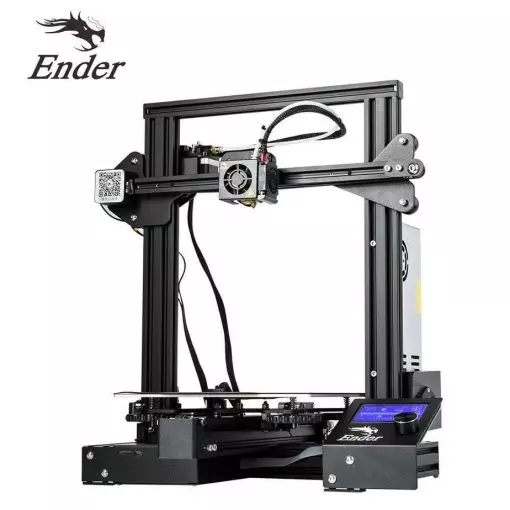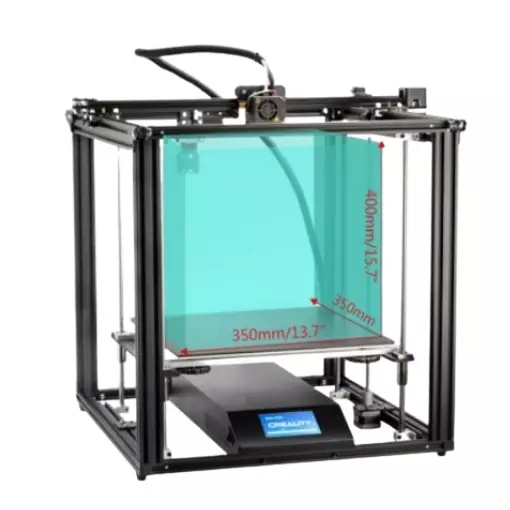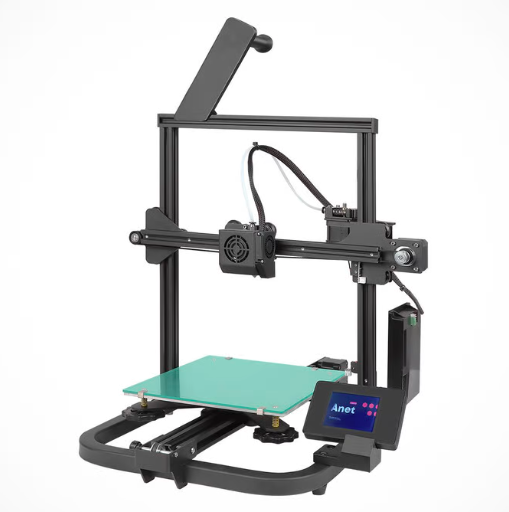Compare Ender 3 vs Ender 5 Plus vs A8 V2
Comparison between the best 3D printers
Choose the best 3D printer at the best price. The cheapest 3D printers are here.
Buy a 3D printer here with 3D Fila.
 |
 |
 |
|
| Model | Ender 3[BUY Ender 3] |
Ender 5 Plus[BUY Ender 5 Plus] |
A8 V2 |
| Printing Material | Filament | Filament | Filament |
| Estimated price | $210,00 | $599,00 | $129,00 |
| Fabricante | Creality 3D | Creality 3D | Anet |
| Release Year | 2018 | 2019 | 2021 |
| Print Volume [mm] | 220x220x250 | 350x350x400 | 220x220x250 |
| Printer Size [mm] | 440x440x465 | 632x619x666 | 428x441x486 |
| Weight [kg] | 6,62 | 18,2 | 6,2 |
| Power Loss Recovery | NO | YES | NO |
| Enclosed printer | NO | NO | NO |
| Bed Leveling | Manual | Automatic | Manual |
| Filament End Sensor | NO | YES | NO |
| Bed type | Heated | Heated | |
| Power supply system | Bowden | Bowden | Bowden |
| Standard nozzle | 0,4 | 0,4 | 0,4 |
| Maximum Nozzle Temperature [°C] | 255 | 260 | 230 |
| Maximum Bed Temperature [°C] | 110 | 100 | |
| Maximum printing speed [mm/s] | 180 | 180 | 150 |
| Filament holder | YES | YES | YES |
| Camera for supervision | NO | NO | NO |
| Recommended filaments | PLA, TPU, ABS, PETG | PLA, TPU, ABS, PETG | PLA |
| Recommended slicers | Cura, Simplify, Slic3r | Cura, Simplify, Slic3r | Cura, Simplify, Slic3r, IdeaMaker |
| Maximum Resolution [mm] | 0,1 | 0,1 | 0,1 |
| Processor | 8 bits | 32 bits | |
| Display | Mono | Touchscreen TFT 4,3'' | Display touchscreen 2,8'' |
| Power Supply | 24V / 270W | 24V / 504W | 110/220V / 250W |
| Connectivity | SD / USB | SD / USB | SD / USB |
| Operating systems | Windows, Mac, Linux | Windows, Mac, Linux | Windows, Mac, Linux |
| Date of registration in the system | 2021-04-13 | 2021-04-14 | 2022-11-10 |
| Release date | 2018 | 2019 | 2021 |
| Extra features | The Ender 3 V1 is a DIY assembly 3D printer, a sales leader since 2017, standing out for its cost-benefit. With a wide printing capacity, it has a CNC machined structure for precision and stability. It offers high-precision prints with low noise, thanks to its innovative V-profile and pulleys. It has a self-adhesive magnetic platform for easy removal of models and excellent adhesion. The Ender 3 heats up quickly, reaching 100°C in 5 minutes, ideal for agile prints. It includes protection against power failures, allowing you to resume printing after interruptions, saving time and material. | The Ender 5 Plus offers a large print volume (350x350x400 mm) and fast assembly. It includes a BLTouch sensor, but with range limitations. It stands out for its dimensional accuracy, although it requires adjustments to the slicer settings. Despite the noise, its integrated design saves space, and includes features such as a filament sensor and power resumption. Ideal for large projects, it requires refinement in the settings for high-quality prints. | The Anet A8 V2 is a Cartesian-XZ type 3D printer with a build volume of 220 x 220 x 250 mm, Ender 3 design and V-slot assembly. It has a 32-bit motherboard and touchscreen interface, promising ease of use. It uses open source firmware and has thermal failure protection. It stands out for its cable organization and the absence of a heated bed, focusing on energy savings and PLA printing. It comes with an external power adapter, aiming at greater safety, especially for beginners and educational use. |
| Support for multiple colors and materials (AMS and CFS) | NO | NO | NO |
Notes * |
|||
| Cost-benefit | 6 / 10 | 6 / 10 | 6 / 10 |
| Hardware | 0.5 / 10 | 2 / 10 | 0.6 / 10 |
| Screen | . | . | . |
| Print volume | 3 / 10 | 4 / 10 | 3 / 10 |
| Performance | 1 / 10 | 1 / 10 | 1 / 10 |
| [BUY Ender 3] | [BUY Ender 5 Plus] |
Conclusion |
| In conclusion, when comparing the three 3D printers—Ender 3, Ender 5 Plus, and A8 V2—a clear distinction emerges based on features, printing capabilities, and overall value for the price. **Ender 3** is an excellent entry-level option, offering a good balance of price and functionality. It has a solid reputation for reliability and quality, making it ideal for beginners and those looking for a cost-effective 3D printing solution. However, it lacks some advanced features like power loss recovery and automatic bed leveling, which may require more effort in setup and calibration. **Ender 5 Plus**, while being the most expensive of the three, justifies its price with a larger print volume and more advanced features. The automatic bed leveling and filament end sensor enhance usability, making it suitable for larger projects and more intricate designs. However, users should be prepared to invest time in optimizing slicer settings for best results. **A8 V2**, on the other hand, presents a very affordable option. However, it is geared more towards beginners and educational use, lacking some of the robust features present in the other two models. It performs decently for basic PLA printing but has limited versatility regarding filament types and printing speeds. Ultimately, the best choice depends on the user's needs. For beginners on a budget, the **Ender 3** is highly recommended. For those who require larger prints and added features, the **Ender 5 Plus** would be worth the investment. Meanwhile, the **A8 V2** serves as an economical option but may not meet the needs of more advanced users seeking versatility and functionality. |

